In collaboration with Matteo Ginesi, Github
The recent security needs due to the Covid − 19 pandemic have led to the creation of facial recognition systems that must extend further with respect to the normal capabilities of classic CNN solutions. Facial recognition networks usually exploit the presence of hidden features within the images, which are extracted from the convolutional layers and categorized with “fully connected layers” that return fundamental facial parameters or, in less complex applications, the presence or absence of a face in the image.
This work consists in the creation of a robust convolutional network that is able to discriminate covered or not covered faces in a more robust way to overcome mask presence in photos. This led us to the study and development of a network (in the convolutional part) that could primarily recognize a face from any photo. The rigidity to errors of this “step” allowed us to develop and refine all the other aspects for the discrimination.
Dataset creation
The main initial difficulty we encountered was building a dataset that was right for our purpose. There are many datasets on the web for training networks for face recognition but none of them had the right requirements we needed. This prompted us to create our own dataset built by unifying others with the following characteristics:
-
3828 images of uncovered faces
(extracted from Flickr-Faces-HQ Dataset[3]) -
3725 images of mask-covered faces(custom dataset scraped from google based on keywords which are royalty free and comes under fair use)
-
3710 random images (scraped from google are also royalty free and comes under fair use)
Dataset sub-set
Random images
It is a sub-dataset build upon a different variety of images in order to build “stiffness” to the simple task of binary classification between face and no face. The dataset have been augmented in terms of image sizes, rotations, translations, color palettes and proportions. Other than faces this set of photos is made of animals, computer parts, insects, furniture, real and drawn fruits and vegetables, flowers, landscapes, buildings, money, cups, airplanes, plants and trees, musical instruments, fossils, tools, boats and guns (all unrelated subjects to faces).
Uncovered faces
This sub-dataset is a composite of different faces from distinct regions which makes it possible to use it in most of the countries without false positives and it isn’t augmented: developemnt results shown us problems of overfitting even after small number of epochs and no other benefits at all. The only augmentation present is on a small proportion of it and involves only mirroring and small rotations in order to get balance between the various categories in it. Faces are provided with and without glasses, to accommodate the network’s results to a common item and, therefor to increase overall accuracy.
Mask-covered faces
No overall augmentation. Because this dataset is a synthetic dataset which is generated by a GAN and even though the overall dataset has same color and same shaped masks. Our model is able to generalize the images much more accurately than we thought.
Dataset classes
We have implemented networking in python via the pytorch framework. The first thing we have done is the creation of dataset class in order to load and prepare data. From our set of image a loader is made of:
-
Resized images of 32 × 32 pixels
-
Normalized RGB values in the range of 0 ÷ 1 32-bit floating point
-
Tensor data
-
No run-time augmentation
Augmentation can be tricky in terms of accuracy and overfitting: we decided to use augmentation only for the mask-covered and uncovered faces. For what concern other data management, the dataset is divide in a k-folded stratified agglomeration both for test and validation, with a batch size of 32.
CNN model for face mask detection
The convolutional network model that we have created can be schematized as follows; for the input we have a three channels image 32 × 32 (R,G,B colours), for the output we have integer classification classes (0÷2):
0: No mask detection
1: Mask detected
2: No mask recognition (not present nor human being subject)
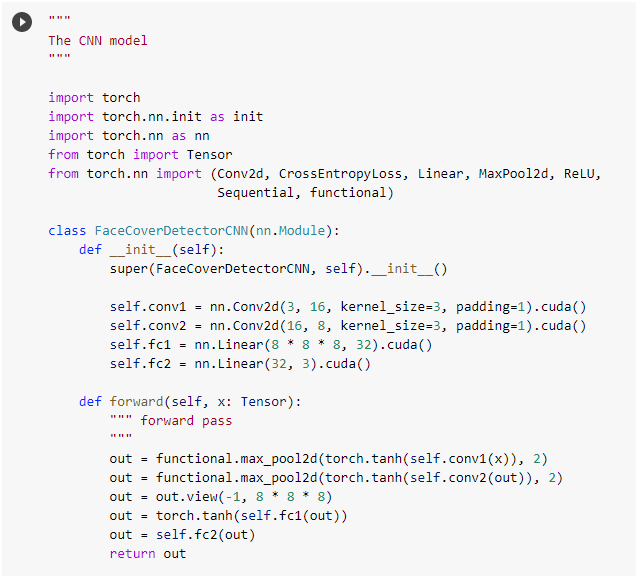
The CNN is composed by four layers (Table 1.1): two convolutional and two linear fully-connected, the overall trainable parameters are 18123.
| Layer | Layer type | Output shape | Parameters |
|---|---|---|---|
| 0 | Conv2D | [−1,16,32,32] | 448 |
| 1 | Conv2D | [−1,8,16,16] | 1160 |
| 2 | Linear (FC) | [−1,32] | 16416 |
| 3 | Linear (FC) | [−1,3] | 99 |
FC stand for Fully Connected. The value − 1 in the output shape stands for “no value required”.
Training phase
The training phase is composed as follows: for each batch get the images and its labels and then get prediction by the model (CNN). Do the comparison between actual and predicted values.

After several development tests, in order to avoid overfitting or any accuracy losses, the best training method results to be with 40 training epochs, Cross entropy loss function between outputs and labels, Adam optimizer for optimization and learning rate of 0.001.
Results
Evaluation tests
Here are some random evaluation examples. Remember that classes are 0 for no mask, 1 face covered by a mask, 2 no mask recognition (not present nor human being subject).
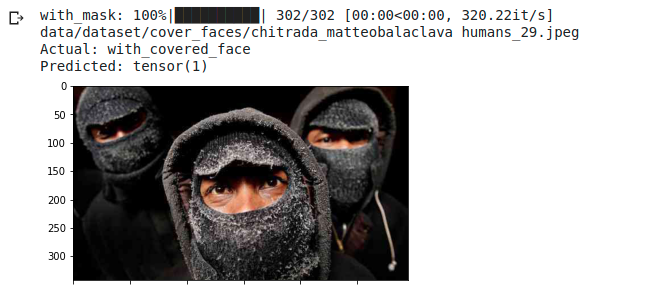

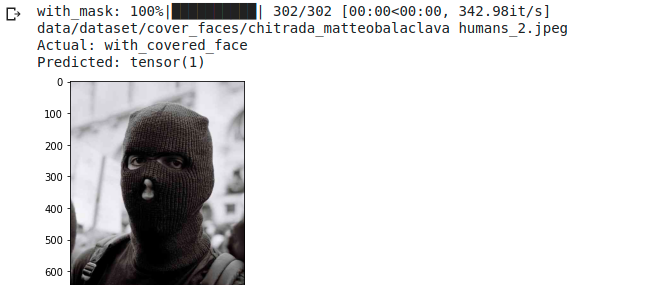

The examples shown in (Fig. [fig: balaclava examples]) are “true” that is, no miss-classification errors were made. We can see how the network is able to manage images with more people (see (Fig. [fig: balaclava examples]-1) and with distorted or unnatural colors (Fig. [fig: balaclava examples]-3 and 4). Finally we can guess on which hidden variables the network is able to extract the various features in the last photo.
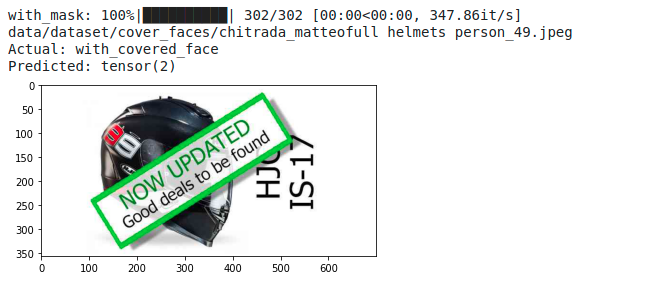
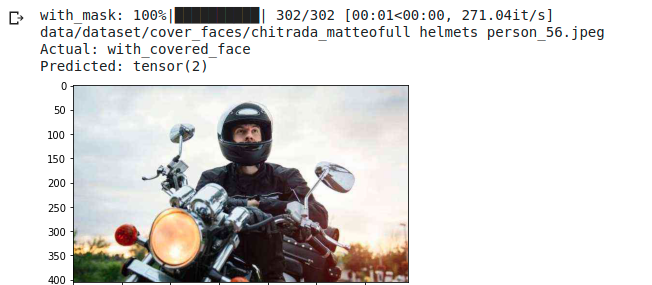

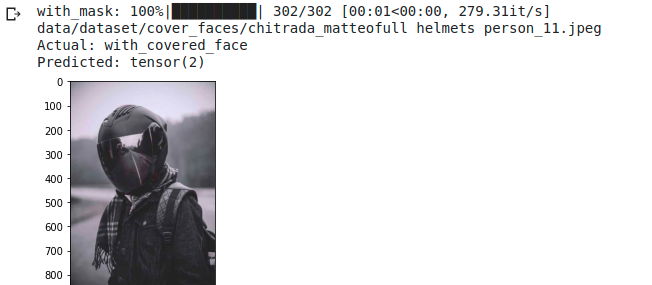
In the this sample batch (Fig. [fig: helmet examples]) we can see how for extremely rotated or completely covered faces, the network classifies as “no mask detected”.
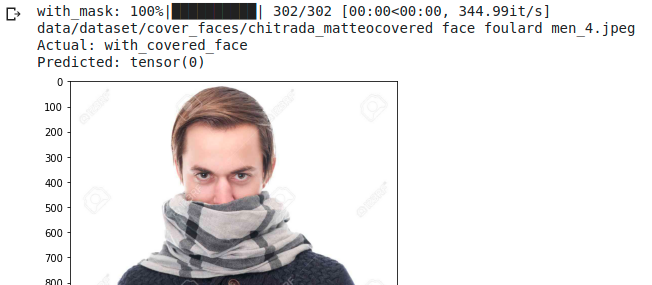
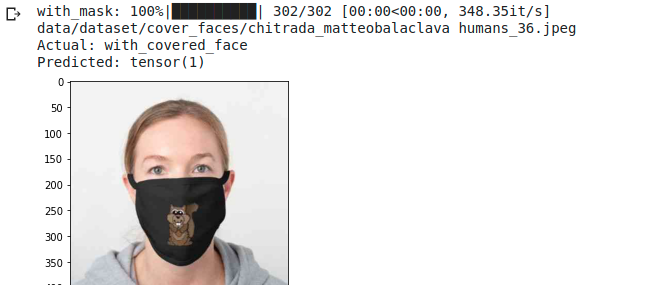
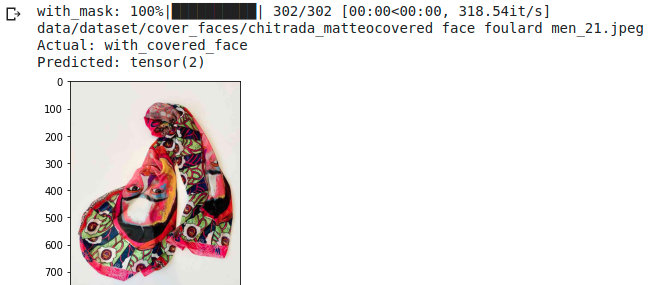
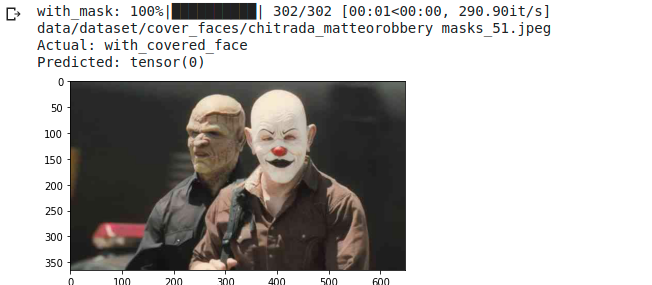
The first image (Fig. [fig: others example]) is an example of miss-classification: the photo is an obvious person covered by a scarf but the network interprets it as “no mask detect”. This lead us to increase the number of epochs, the size of the dataset and (even if development times can be much longer) the complete redesign of the layers of the convolutional network. The second image as shown in (Fig. [fig: others example]) is perfectly classified: the presence or absence of the nose is assumed to affect the hidden variables and therefore also the features that are extracted. In the third image the classification is perfect, but as previously mentioned we have worked on the quality of the discriminator on the “not facing” images to reduce the presence of errors in the following stages. The last one instead shows the robustness of the entire network even in the presence of several faces at the same time.
Performances
Most of the images are properly classified, as we can see from the confusion matrix (Fig. [fig: confusion_matrix]), while only a very small fraction is miss-classified (less than 10%). The metrics show us the quality of the desciminator in more detail. We can see how the main values are all above 90%.

 [fig: confusion_matrix]
[fig: confusion_matrix]
Accuracy
In development stage we saw that already at the first epochs of k-folding the accuracy does not go overfitting. All the optimization work done both on the network and on the dataset have led to avoiding overfitting even throughout the training course. This is a sample plot of the first epochs: even in a small number is evident how overfitting doesn’t affect the first “runs” of the evaluation.

New implementation and development
The first thing we thought about changing was the accuracy. To do this
we analyzed the data realizing how they were easily influenced by the
type of training (speaking of the division of the dataset into
“training” and “validation” sets). In addition, the evaluation made
using the “k-fold” method is energy-intensive and very long-lasting, but
giving unsatisfactory results: a useless effort. As for the geometry of
the CNN network used (layers, depth, activation function,
fully-connected layer) the size of the input images is limited to files
32 × 32 px*: even reaching an accuracy of 86%, analyzing the trend of
the loss function and of the error in training, we realized that we were
on the verge of overfitting even with very low learning rate values (in
the order of 0.0005). We therefore decided to change the order.
Firstly, CNN Net is called in the python code FaceMaskDetectorCNN(),
it is still valid for comparison purposes, even with images dimension
limit of 32 × 32 *px. The new network is a modified pre-trained
ResNet50 and then the training method in order to get track of epoch’s
metrics (accuracy in primis) this phase is composed, for each epoch, of
a training phase and a small evaluation (at 10 batch samples).
Implemented network
A pre-trained ResNet50 model is used, with the last fully connected layer modified to fit our specification on output classes and be trained with our dataset. The size specification table can be found at Table 2.1
1fil
| Total params | 24, 562, 250 | Forward/backward pass size | 374.28 MB |
| Trainable params | 1, 054, 218 | Params size | 93.70 MB |
| Non-trainable params | 23, 508, 032 | Estimated Total Size | 468.73 MB |
| Input size | 0.75 MB | [Table: 2.1] |
Specification of the ResNet50 pretrained model.
An architecture scheme of the network is showed below (Fig. [fig: ResNet50]).
1fil 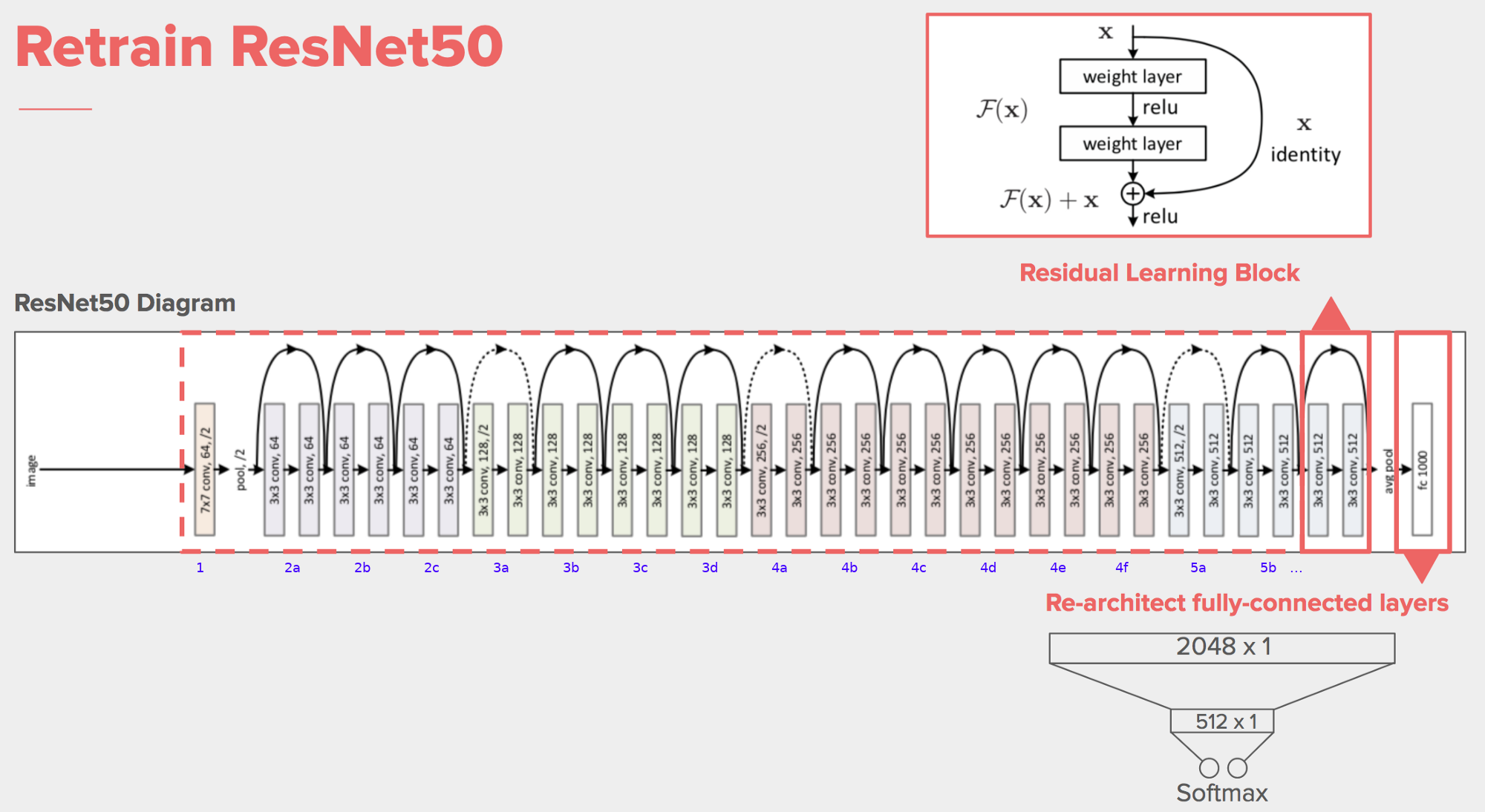
Data management
To maintain continuity and backward compatibility with the old network and its dataset, we have optimized the loading of data. By parameterizing of input figure size to accommodate the input layer of the ResNet50 network. Data loading functions have been paralyzed both in presence of single or multiple GPU computing units. The whole dataset is divided into two major parts: training data (80% of total images) and evaluation data (20% of total images). As far as the dataset is concerned, nothing was done: we kept the same hard-built dataset with all the specification already mentioned.

Training phase
Network’s training phase has been completely rewritten simplifying it in
terms of timing, complexity, increasing the speed of execution both with
the network written by us and ResNet50, in which the only notable
difference is a performance improvement in terms of accuracy. The
workflow has been simplified: for each epoch, small batches of
predefined sizes are fed to the network (finely researched to keep the
speed/computational resources ratio balanced), after which the loss
function is calculated as:
For ResNet50: negative log likelihood
For our CNN: Cross entropy loss Optimization operations (through the
Adam algorithm, acting on the parameters of the network with a
pre-established constant learning rate). The value of the loss function
is saved in order to average it for each batch and be graphed.
Evaluation phase
With bacth size of 256, within the same epoch, the network is evaluated, thus being able to calculate, always on average, both the train loss and the evaluation/test losses.
Metrics
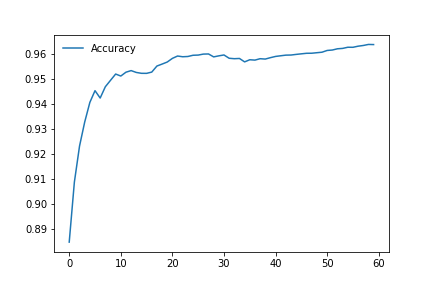
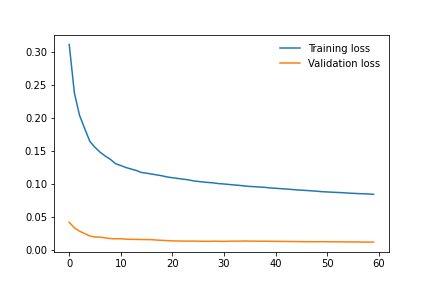 [fig: 2.4]
[fig: 2.4]
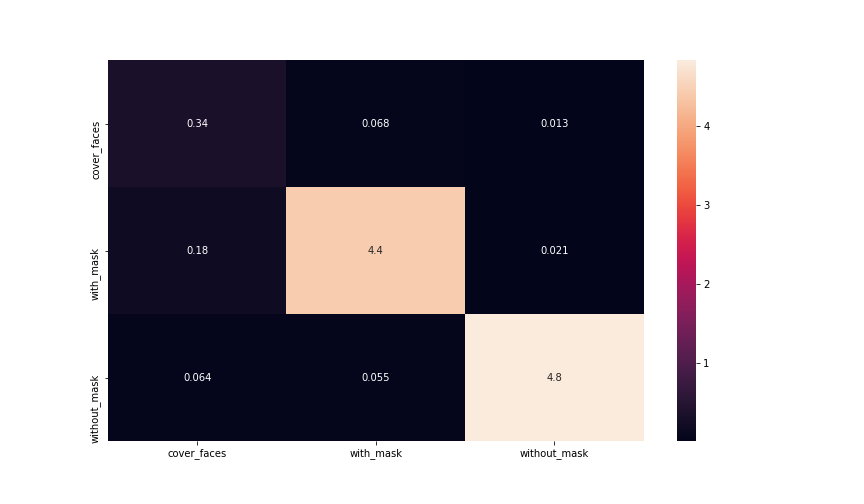
Final results
Total train + eval time: 01:21:51
Batch size: 256
Workers: 128
Resize param: 256
Epochs: 60
Learning rate: 0.0005
Model: ResNet50
Metrics report:
precision recall f1-score support
cover_faces 0.58 0.81 0.67 98
with_mask 0.97 0.96 0.96 1092
without_mask 0.99 0.98 0.98 1166
accuracy 0.96 2356
macro avg 0.85 0.91 0.87 2356
weighted avg 0.97 0.96 0.96 2356
We can see how the learning rate is very low (0.005): this is because the network tends to go immediately into overfitting. In order not to intervene too much on the ResNet50 or not to completely disrupt our initial network, we have chosen to keep this value low, at the expense of a longer training, but as can be seen from the data there has been a significant decrease: from more than 8 hours to about 1 hour and 20 minutes.
Old CNN on new training phase results
The comparison between the CNN network model written by us and ResNet50 led to these results. From (Fig. [fig: 2.4]) we can observe the training and validation losses which shows us a good training behavior with steady decreasing losses. Based on the heatmap from (Fig. 2.1) we can see our model has a good generalization behavior, however our network involves the achievement of excellent levels of accuracy, but never reaches or exceeds the ResNet50. The results (with relative timing) of the two training carried out are indicated below.
Our network, at the expense of lower accuracy (less than 86% or 92%), training times are drastically shorter, but above all the size of the models and the need for computational power are considerably lower than the other. This would allow the implementation in portable, embedded or edge-computing systems: this is not unimportant at the production and distribution level.
Training on 120 epochs
Total train + eval time: 01:58:36
Batch size: 128
Workers: 128
Resize param: 32
Epochs: 120
Learning rate: 0.001
Model: FaceMaskDetectorCNN
Metrics report:
precision recall f1-score support
cover_faces 0.61 0.27 0.38 92
with_mask 0.89 0.94 0.92 1101
without_mask 0.95 0.93 0.94 1163
accuracy 0.91 2356
macro avg 0.82 0.72 0.74 2356
weighted avg 0.91 0.91 0.91 2356
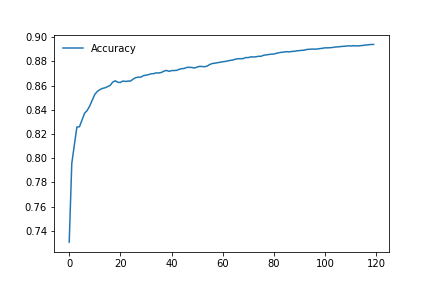
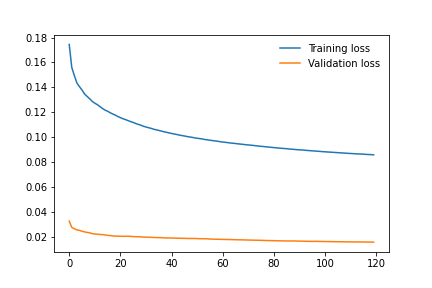
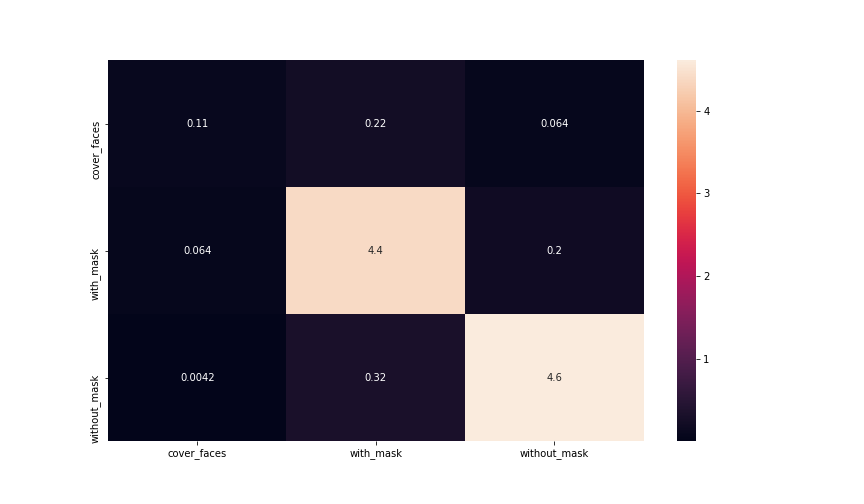
Training on 240 epochs
Total train + eval time: 03:22:14
Batch size: 128
Workers: 128
Resize param: 32
Epochs: 240
Learning rate: 0.001
Model: FaceMaskDetectorCNN
Metrics report:
precision recall f1-score support
cover_faces 0.76 0.33 0.46 87
with_mask 0.88 0.96 0.92 1096
without_mask 0.96 0.92 0.94 1173
accuracy 0.92 2356
macro avg 0.87 0.74 0.77 2356
weighted avg 0.91 0.92 0.91 2356
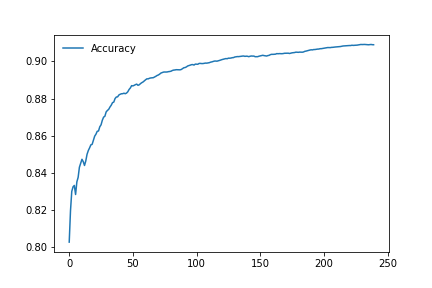
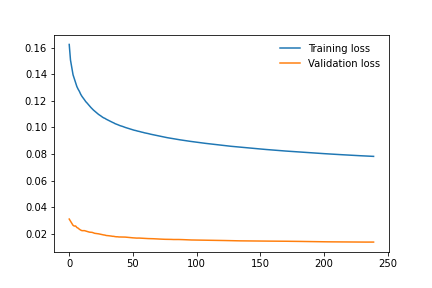

Conclusions
Further improvements and developments
For each training, a file of the model trailed is created and saved as:
<model_name>_rp##_e###_lr#####.pth
-
model_name: eitherResNet50andFaceMaskDetectorCNN -
rp: image resize parameter (eg: 32 × 32 p**x images) -
e: epochs -
lr: fixed learning rate
so that the implementation for use as a classifier can be carried out in
the simplest and most flexible way possible. In fact, the model is
complete with all the necessary information, it does not need training
or various modifications and it can be loaded directly through the
pytorch model.load(file_name) functions both through the python
front-end and through the use of the pytorch library (C++ front-end).
This allows implementation on both low-power embedded systems and larger infrastructures in order to leave the user the choice between edge-computing and cloud-computing. The classification times, thanks also to the reduction of the input image, are around values below one second. It should also be remembered that all the calculated performance values are carried out during the training phase through the splitting of the dataset and the consequent creation of a sub-set of evaluation images, which is carried out every 10 (even if the value can be modified) batch set. The evaluation phase has negligible times, less than one minute in all tests carried out so far.
Conclusions
The face mask detection task is achievable by the above designed implementation, for accuracy values below 96%, based on our evaluation on the network. This is due to the datasets distinct environments and conditions are limited compared to the real life scenarios. To address this problem, a larger real-life, with different geographic regions image sources can be used to achieve more reliable and generalized model, hence more accuracy and better overall scores.
As the model is not designed for life threatening situations it can be used as a safe alternative to in-person verification of masks in public during this global pandemic conditions. We can also say that as our model surpasses the threshold of 90%, any public place can be equipped with a low-energy and low-cost without cloud-computing (which is hard to reach in rural and remote areas). In the end, the proposed model and experiments which have been performed in this paper are done with performance limitation in mind so that it would be feasible to deploy in a less expensive system.
[3] Flickr-Faces-HQ Dataset (FFHQ), https://github.com/NVlabs/ffhq-dataset, Nvidia.
